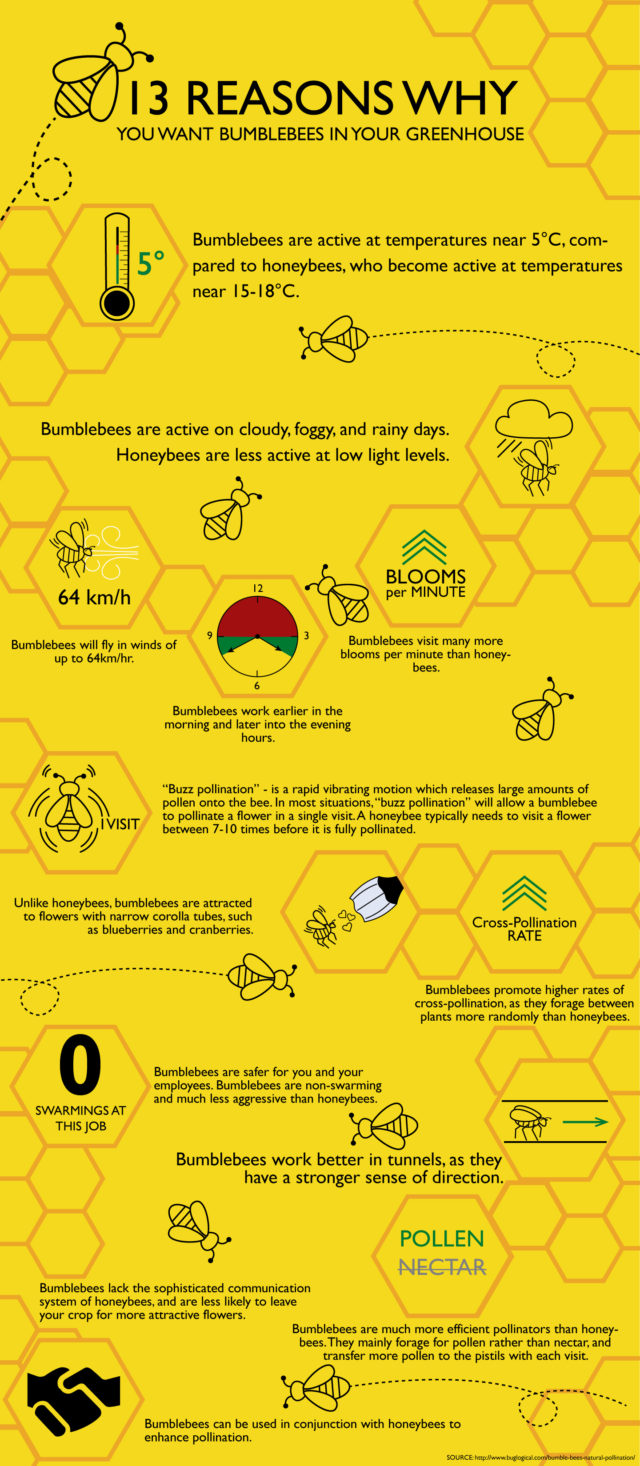There has long been discussion on the topic of which type of bee is best to pollinate greenhouse crops, bumblebees or honeybees? Historically, honey bees were used by farmers for pollinating food crops, increasingly however, other bee species are being recruited to help out. Today we will give you 13 reasons why you want bumblebees in your greenhouse as a main pollinator.
Reason #1
Active period
Bumblebees become active at way lower temperatures (around 5°C) than honeybees, who become active at about 15-18°C. This means an extended pollinating period every season. However, it is very important to have plants throughout season, especially during cold periods.
Reason #2
Low light activity
A Bumblebee is more active on cloudy, foggy and rainy days compared to a honeybee, who won’t even fly out of the hive in that type of weather.
Reason #3
Fly speed
A Bumblebee will fly in winds up to 64 km/hr. It won’t make a huge difference in terms of a greenhouse pollinating (average wind speed in the greenhouse is around 4-5 km/h), but they are definitely not going to be blown away from your greenhouse.
Reason #4
Active hours
Bumblebees have a longer work period per day than any other pollinators. This will give you an increase of about 20-25% in pollinating period a day.
Reason #5
Blooms per minute
Bumblebees visit many more blooms per minute than honeybees. Add this to our previous points, and you will have a much faster overall bloom speed ratio.
Reason #6
“Buzz Pollination”
Bumblebees have a special way of pollination called: “Buzz Pollination”. It is a rapid vibrating motion which releases large amounts of pollen . Buzz pollination will allow a bumblebee to pollinate a flower in a single visit. Whereas a honeybee must visit a flower seven to ten times before it fully pollinates a flower.
Reason #7
Attraction to specific flowers
Bumblebees have longer “tongues” than honeybees and can forage for pollen more efficiently from flowers with narrow corolla tubes such as bell pepper, tomato, blueberry plants and more.
Reason #8
Cross-pollination
Bumblebees fly between plants more randomly than honeybees. This will promote higher rates of cross-pollination in your greenhouse.
Reason #9
Less swarming
Bumblebees are safer for you and your employees. Bumblebees are non-swarming and much less aggressive than honeybees.
Reason #10
Sense of direction
Bumblebees have a better sense of direction, making them more useful in a protected or semi-protected greenhouse. Honeybees have a hard time orienting themselves, and many become lost through banging against the glass.
Reason #11
Lack of communication
This might sound like a reason against bumblebees in your greenhouse, but think of that lack of sophisticated communication system reducing the likelihood of bumblebees leaving your crops for more attractive flowers.
Reason #12
Pollen over nectar
Bumblebees mainly forage for pollen, rather than nectar, which makes them much more effective pollinators than honeybees. Pollen is a fine powder of microscopic particles from the male flower that can fertilize the female flower to produce seed. Pollen is produced by anthers, the male reproductive organs found in most flowering plants. Nectar is a sweet substance, produced by some plants to attract pollinators such as bees, butterflies and hummingbirds. Bees collect nectar and make it into honey.
Reason #13
Team work
Bumblebees can be used in conjunction with honeybees to enhance pollination, this results in improved yields.


Written by – Ilya Ryzhkov joined P.L. Light Systems on a student work term and continued his employment with us through his 2017/2018 year of study.


